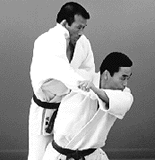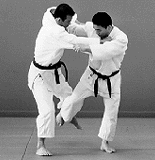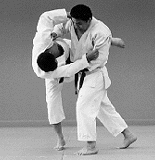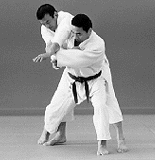Tai-Otoshi (hand technique)
Tai-otoshi is making Uke off balance in a right forward position (or left forward position). Then, Tori spins his body to the left (or right) by stretching his right leg (or left) in front of Uke's right (or left) foot. Tori, then, pulls down Uke's body forward over his stretched leg for a throw.
(Type 1) When Uke steps back, Tori steps forward to put Uke into a floating position, then executes a Tai-otoshi
Tori & Uke hold each other in a natural right-handed posture.
As Tori steps back, he pulls Uke forward and stops by pressing down on Uke's body. Uke tries to stop with his right foot, but since his body is off balance in a forward position, he will try to pull his right foot back to his normal posture.
At this moment, Tori will lower the pressure in both hands and push Uke with his left hand. Uke reacts by bringing his right foot back and tries to return his body to a straight position.
At the moment when Uke's right foot steps back slightly more than his left foot, Tori steps his right foot in between Uke's legs. Tori, then, pulls his left foot and twists his body half way to the left, while he pulls the left hand in a upward motion and pushes up with his right hand. Since Uke cannot shift his weight on his right foot, he ends up on his tiptoe in a floating position.
Tori spins his body by stepping his left foot further back, then, lowers his body and stretches his right leg in front of Uke's right ankle in a cross position.
At this time, Tori should open both legs widely and bend his left knee with the right leg stretched to lock into the throwing position (picture 1).
 picture 1 |
Tori lifts up Uke with right hand and pulls down his left hand, and concentrates all his power into his hands, hip and legs to execute the throw, down forward. Uke falls in a big circular motion with his right toe as the point of rotation.
This Tai-otoshi is the most commonly used.
Techniques of practical applications
1. Two motion Tai-otoshi.Tori uses his right foot to swing up Uke's left leg lightly outward to break his balance in a right forward position. Then, the throw is executed as previously explained (picture 2).
The purpose of Tori's right foot movement is to try to break Uke's balance to a right forward position. Therefore, it is not a combination technique from Ouchi-gari to Tai-otoshi.
2. Dodging Uke's Uchi-mata
to change into Tai-otoshi.Tori dodges Uke's left Uchi-mata by stepping back his right foot. The moment Uke loses his balance into a right forward position, Tori steps his right foot forward in front of Uke's right foot in a cross position to throw down (picture 3).
In the event Tori dodges Uke's Uchi-mata to throw Uke, it is called Uchi-mata-sukashi.
picture 2
picture 3
(Type 2) Tori grabs Uke's right collar and right sleeve to execute Tai-otoshi
Tori grabs Uke's right collar with his right hand with four (or five) fingers placed inside, and the left hand grabs Uke's right sleeve (or right collar below the right hand).
Tori steps back slightly with his left foot and turns his body half way and moves to Uke's left side to cause Uke to lose his balance to his right forward. Tori steps in front of Uke's right foot to cross position and Tori grabs Uke's collar and pushes up against Uke's chest, then, pulls down and throws.
This is a different way of using hands compared to (type 1).
This techniques is similar to Seoi-nage (type 2) (Kata-eri-seoi) but the usage of the right hand is different.
Tai-otoshi: Tori tucks right fingers between Uke's collar and chest and throws Uke without body contact.
Kata-eri-seoi: Tori places his right elbow under Uke's armpit and picks up Uke and throws (picture 4).
 picture 4 |
(Type 3) Crossing Uke's both hand to execute Tai-otoshi
Tori is in left handed position and Uke is in right handed position. Tori grips Uke's collar in the back with his left hand (Uke's right hand grips Tori's left front collar). Tori grips the edge of Uke's right sleeve (Uke's left hand is free) and pulls downward with both hands to bend Uke's body forward.
Resisting this position, Uke steps left foot forward as he pushes Tori's left wrist to straightened up to return to the original posture.
A second before Uke's resisting movement, Tori pulls the left foot back and steps his right foot forward to become a right handed posture. By releasing his left hand grip, Tori quickly grabs the edge of Uke's left sleeve with the same hand. Tori steps back with his left foot while twisting his body to the left and by pulling both hands downward crosses Uke's arms.
At this time, Tori puts his right shoulder under Uke's left armpit (or puts his right shoulder against Uke's left elbow) and stretches his foot across Uke's right foot (picture 5).
Then, Tori pulls his left hand across his hip and stretches his right hand straight forward and by twisting his body to the left pulls Uke down into a throw.
This technique is rarely used in a competition. This type of Tai-otoshi was created from grappling fight.
The key point of this technique is how to cross Uke's arms during grappling fight.
 picture 5 |
Techniques of practical applications
Tori & Uke hold each other in normal position. Uke tries to grip Tori's left sleeve with both hands to push away. At this point, Tori grabs the inside of Uke's left sleeve with his left hand.Tori's right hand grabs Uke's right sleeve by reaching under his left arm. As Tori pulls both of his hands, he crosses Uke's arm for control. Tori, then, twists his body to the left and places his right foot in front Uke, and pulls down to throw (picture 6).
picture 6
- Seoi-Nage (hand technique)
- Ippon-Seoi-Nage (hand technique)
- Seoi-Otoshi (hand technique)
- Tai-Otoshi (hand technique)
- Sukui-Nage (hand technique)
- Kuchiki-Taoshi (hand technique)
- Morote-Gari (hand technique)
- Uchi-Mata-Sukashi (hand technique)
- Uki-Otoshi (hand technique)
- Kata-Guruma (hand technique)
- Sumi-Otoshi (hand technique)
- Kuchiki-Taoshi (hand technique)
- Kibisu-Gaeshi (hand technique)
- Kouchi-Gaeshi (hand technique)
- Yama-Arashi (hand technique)





